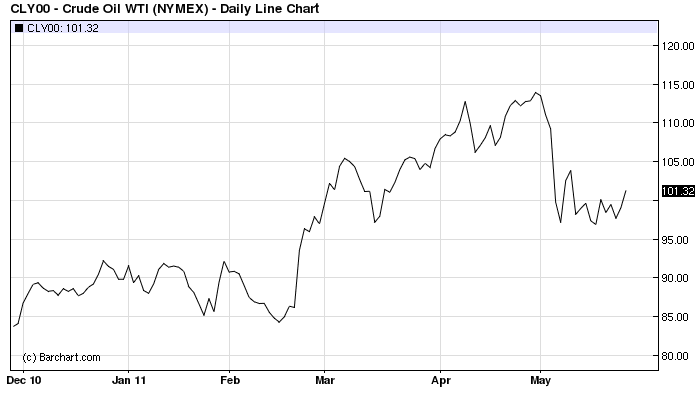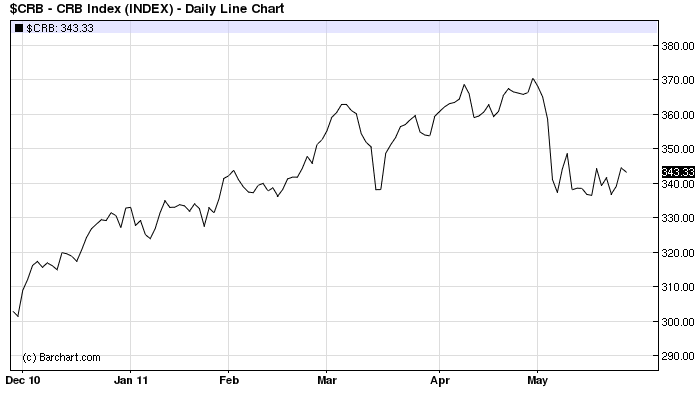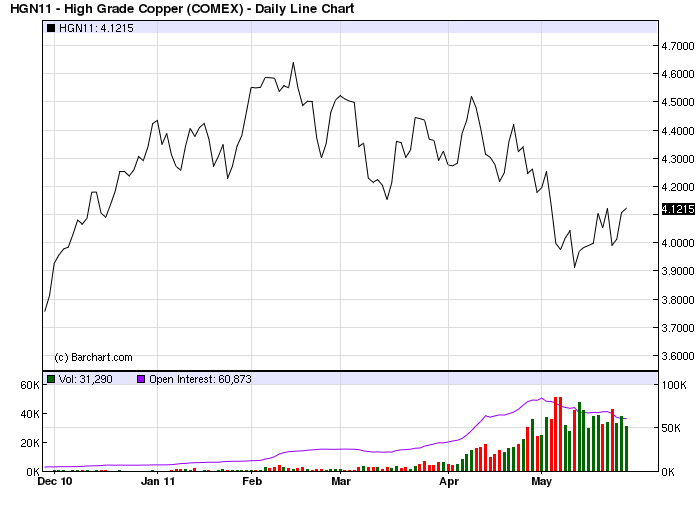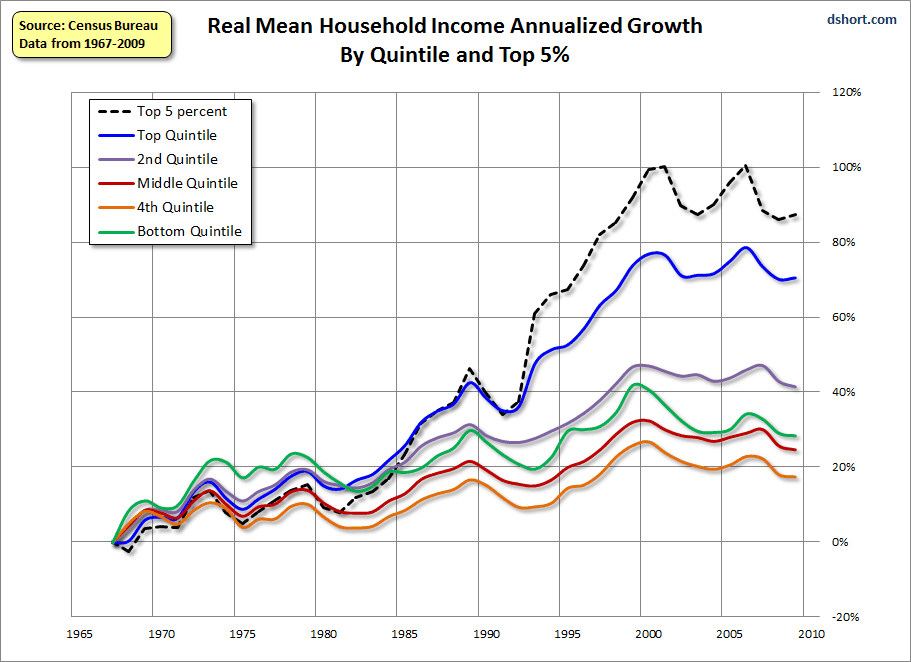
I really don’t think so.
There are some fair reasons to think we might bounce in the short term. From the FT:
Equities and commodities continued to stabilise following the risk sell-off seen at the start of this week, although nagging worries over eurozone sovereign debt kept anxiety levels among investors high.
The latest concerns centred largely around Greece’s political stability, given reports of a snap general election or a possible referendum over planned budget cuts and asset sales. The government denied the rumours.
“The focus right now is on whether Greece will follow through on agreed-upon austerity measures amid widespread local dissent,” said Michael Woolfolk, of BNY Mellon.
“Judging from recent remarks by EU officials, there is little doubt that Europe will provide the funds needed to keep Greece from a full default. However, the question has now become whether the so-called ‘reprofiling’ of Greek debt is a technical default.”
Jane Foley, senior currency strategist at Rabobank, commented: “Increased pressure on Greece to step up its privatisation programme may buy the country more time; restructuring worries may be postponed and a potential conflict with the European Central Bank offset for now.”
Sterling reached a two-month high against the euro, even after the second estimate of firstquarter UK GDP confirmed the sluggish start to the year made by the economy
But she added: “Whether or not enough has been done to prevent contagion spreading further into the eurozone remains to be seen.”
That sounds about right. But, we are going to see a default and the ratings agencies are certain to define it that way. It may go OK, and if it does, we’ll see a relief rally. But to date, the stabilisation of commodity markets has been highly unconvincing. Look at oil:

That’s hardly a strong bounce. The same pattern is apparent in the entire commodities complex. The CRB:
And leading the lot is Dr Copper, which looks to have found an established new trend, down:

If we take copper as a proxy for global growth, the top is in. And in that event, we need to be asking how bad the global economic slowdown will be, which goes well beyond European problems. Pragamtic Capitalist has a useful piece in this regard on the US economy:
Danske Bank has a nice piece of research out that provides the other side of the bearish view on all the recent economic data. They actually believe the data in the near-term will continue to be very weak. Specifically, they say the ISM data is likely to mean revert (something I wholeheartedly agree with). But they think it’s incorrect to get overly bearish because of this. In fact, they say it will result in a “false growth scare”:
“We believe that we are going to see more signs of weaker activity from different indicators in the coming months. For example, the US ISM manufacturing index is expected to decline in coming months as indicated by the Philadelphia Fed survey. Declines in PMI in other countries such as Euro Flash PMI for May point to a slowing global industrial cycle, which should become visible in the US as well.
Supporting the case for a stronger decline in the ISM manufacturing index is also that hard data have been much weaker than suggested by the ISM index. Firstly, GDP growth was actually below trend in Q1 rising 1.8% q/q annualised. Last time there was such a large divergence between GDP growth and ISM was in 2004 and subsequently we saw a quite fast decline in the ISM index (see chart on page 1). Secondly, industrial production has already slowed. The three-month annualised growth rate was only 1.8% in April, down from the strong levels in mid 2010 of 9.5%.
We believe this may contribute to another “false” growth scare as we have seen quite a few times, when ISM goes down fairly rapidly. At the same time, though, we look for US GDP growth to recover slowly already from Q2 and especially in H2 to a pace of 3.5-4% AR. This will very much mirror what we saw in early 2005 when ISM continued lower coming from a “too high” level relative to hard data while at the same time GDP growth stayed around 3% growth. The growth scare may be heightened by the ongoing budget discussions culminating in late July as we approach the deadline for a raise of the debt limit. This will put focus on the significant tightening of fiscal policy in 2012 and 2013.
As growth recovers and ISM stabilises during autumn, the growth scare should fade again, though, and we may see some relief that growth has not derailed after all.”
Ultimately, they see three primary factors continuing to power the economy higher – declining oil prices, improving jobs and improving credit trends:
“Three factors to support consumption in coming quarters However, the US households will benefit from three important factors:
1. Decline in oil prices: Since early May oil prices have fallen by app. USD15 to USD112 per barrel. We expect oil prices to stay lower and average USD116 for the rest of the year, which means that the PCE deflator is likely to fall back to around 2% by the end of the year giving a lift to real consumption growth of 2 percentage points. This means that more of the rise in nominal spending will feed into real consumption as less is absorbed by price increases.
2. Labour market improving: Another important factor that will underpin consumption growth is the rise in nominal income growth stemming from the improving labour market situation – see Flash Comment: US payrolls point to solid income gains. In April our income proxy derived from the US employment report rose to 5.5%. This income growth stems from a stronger rise in payrolls of 244k and a rise in average hours. Wage growth, though, is very subdued (around 2%) and is dampening overall income growth. In coming quarters we expect job growth to continue around 225-250k and we look for a further rise in average hours. Wage growth is expected to stay low, but in total this should keep nominal income growth in coming quarters around 5-6%.
3. Credit growth rising: The latest Senior Loan Officer Survey pointed to further improvement in credit standards for households and a stronger willingness to lend. Consumers’ demand for credit is also on the rise. This will increasingly underpin private consumption on top of the robust income picture.
In sum, the fundamentals for private consumption look fairly solid and we expect private consumption growth to climb steadily higher in coming quarters to 3.0% in Q2 and 4.0% in Q3 as the headwind from oil prices eases gradually and real income growth rises (there is normally a lag of 1-2 months from oil prices to the PCE deflator). The savings ratio is expected to be broadly flat around 5.5% – as has been the case over the past year after the sharp correction higher during the financial crisis.”
I think this is a pretty reasonable outlook for now. The near-term downside in the economic data will create a headwind for markets, however, I wouldn’t become overly scared about a double dip unless the European crisis gets out of hand, austerity hits the USA or China’s slowdown proves to be something closer to a hard landing.
I don’t want to be a party-pooper but none of these factors look overly strong to me. US income growth has been lousy:

Expanding credit looks a pretty weak rationale given the ongoing housing slide and job growth is accelerating very slowly, if at all, with the weekly DOL figures seemingly stuck above 400k. Lower oil may help may help in the short term
Don’t get me wrong. The US is grinding out a post-bubble recovery through rebuilding its export oriented manufacturing sector, but it’s happening far too slowly to bring on any big bounce in final demand, leaving a big output gap that Paul Krugman sticks his finger into:
Last year I warned that we seemed to be heading into the “Third Depression”— by which I meant a prolonged period of economic weakness:
“Neither the Long Depression of the 19th century nor the Great Depression of the 20th was an era of nonstop decline — on the contrary, both included periods when the economy grew. But these episodes of improvement were never enough to undo the damage from the initial slump, and were followed by relapses.
We are now, I fear, in the early stages of a third depression. It will probably look more like the Long Depression than the much more severe Great Depression. But the cost — to the world economy and, above all, to the millions of lives blighted by the absence of jobs — will nonetheless be immense.”
Brad DeLong points us to Macro Advisers, which has now downgraded its estimates for second-quarter growth. As Brad says, these estimates now suggest that we have now gone through a year and a half of “recovery” that has failed to make any progress toward closing the gap between what the economy should be producing and what it’s actually producing.
That’s it, in a nut shell. And as we’ve discussed before, so long as US growth is weak, confidence in the risk trade is weak also, at least until US growth is weak enough that markets can shift to the expectation of QE3.
But we ain’t there yet, and with US indicators set to slow, QE ending, China tightening, Japan still a mess and Europe’s latest rescue a default, there are significant risks attached to each of the world’s four largest economies and global liquidity.
I agree that barring an accident in each one, global growth will continue, but markets are still too pumped for this gloomy path ahead.

